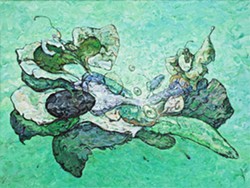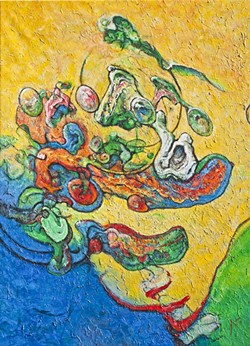
- IMAGE COURTESY OF THE STEYNBERG GALLERY
- GREEN MACHINE: 'Fluid Meditation' spans the verdant spectrum.
After many years of representational painting inspired by the Old Masters, San Luis Obispo artist Jack Artusio took a decade-plus hiatus from showing his work. When he returned to the gallery world last year, what he brought with him was anything but figurative. Now, his abstract paintings grace the walls of the Steynberg once again in his new show, Meditations from Tishlini.
Artusio’s work may be concentrated on abstract forms, but it is rooted in deep feelings of spiritual and psychological “place” that are evident even without explication. The intense, palette-knife strokes of the paintings’ solid backgrounds create a constant sense of movement, with waves of variegated color that can only be distinguished up close.
Many strong canvases are concentrated at the show’s outset, including the green and orange counterparts Fluid Meditation and Floating Meditation, whose organic, bulbous forms and sublime exploitation of color epitomize the show. Each piece is a discrete experience, a separate brain pattern in which a particular thought or occurrence is fully explored. Ceremonial Meditation hints at the regal with its lavender background, but complicates this theme with antennae-like structures at the top of the central figure.

- IMAGE COURTESY OF THE STEYNBERG GALLERY
- TANGERINE DREAM: The citrus hues of 'Floating Meditation' make for juicy viewing.
Artusio’s statement accompanying the exhibit is at once informative and abstract, just like the works themselves. Just in case you haven’t already Googled “Tishlini,” he reveals the origins of the show’s buzzword. “The native name of San Luis Obispo was Tishlini,” Artusio quotes from pioneering early-20th-century cultural anthropologist A.L. Kroeber’s Handbook of the Indians of California. “Why this name is virtually unknown around here,” Artusio continues, “is as much a mystery as are our predecessors who spoke it.” (It’s not exactly a mystery; “tragedy” is probably a better word for it. There is, in fact, a Tishlini Lane in Templeton, though a lone lane hardly makes up for the equivalent of an entire city, not to mention a culture.)
Still, it’s worth being introduced to (or reminded of) this term that has been so thoroughly and effectively marginalized over hundreds of years as to be alien to the majority of its former kingdom’s current inhabitants. Words have a strong alchemy, and it seems clear that for Artusio, this now-archaic designation serves as a guide to his own sense of place. “These paintings for me are meditative windows, or portals, pointing to, honoring, and attempting to connect with this native energy,” he concludes. In the face of the works themselves, this statement feels less colonial and appropriative and more like a key to interpreting the abstract qualities of the paintings, which are clearly intentional rather than improvisational.

- IMAGE COURTESY OF THE STEYNBERG GALLERY
- SURREALIST SPECIAL: Design by Yves Tanguy, color by Keith Haring.
To back the idea up, Hunter Gatherer Meditation hangs to the right of Artusio’s artist statement and bio. Its marine hues and whale-like abstract lead the viewer to wonder whether said scavenging is being done along our local “tar beach”—“pismu” being an indigenous term that has managed to eclipse “Tishlini” in local popularity. Only the occasional appearance of peach tones near the bottom of the central figure hint at the presence of flesh, but could just as easily be sand. Its calm, quiet presentation is more soothing than the idea of foraging for one’s food might suggest.
Next door, Shamanic Meditation introduces a geometrical abstract absent from the other paintings—a white near-square on a blue backdrop, foregrounded by the usual globular figure. The white geometric is, perhaps, one of the portals Artusio mentions in his statement, to which the titular shaman might have access—white being associated with the spirit world in many world art traditions.
Meanwhile, Birthing Meditation contradicts its title with an inorganic black background and a central figure whose colors border on neon. This tension is mirrored in one of six small “studies” for larger paintings, hung together in pairs toward the end of the exhibit. These are neither as grand nor as ultimately satisfying as the larger works, but they do allow the eye to rest momentarily on a more human-scale version of Artusio’s vision, and to inspect the process up close.
In a nod to the Judeo-Christian sensibilities that marked his earliest artistic training, Artusio delays our gratification by saving the best for last: Tishlini Meditation, the show’s eponymous painting and its most dynamic in a gallery full of dynamism. Tishlini Meditation’s macaw-like colors erupt in patters that expand upon patterns the way that thoughts build upon each other in moments of peak creativity. It seems fuller than the other paintings, the culmination of them, punctuated by circular occurrences like Jupiter’s Great Red Spot—neverending storms in the painting’s atmosphere.
- MORE MEDITATIONS: Jack Artusio’s solo show, Meditations from Tishlini, runs through July 27 at the Steynberg Gallery, 1531 Monterey St. in SLO. For more information, call 547-0278.
In the face of so much plein air here in SLO County, Artusio’s paintings are a welcome breath of abstraction. Painting directly from life is so seldom the most artistically productive way of representing the “life” such works claim to capture. The paintings in Meditations from Tishlini represent the Central Coast in a way that is at once nearly impossible to articulate and deeply satisfying. Although Artusio may have looked halfway around the world for inspiration at Italy’s Renaissance painters and the ancient cave art of France and Spain, he’s found his true artistic homeplace right here in Tishlini—or, as Edward Albee wrote, “Sometimes a person has to go a very long distance out of his way to come back a short distance correctly.”
Arts Editor Erin C. Messer meditates quietly to herself at [email protected].
Comments